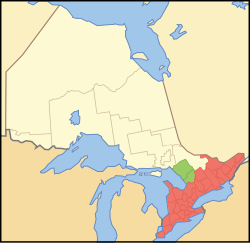
Back انتاریوی جنوبی Persian Sud de l'Ontario French דרום אונטריו HE Ontário Meridional Portuguese Южное Онтарио Russian Southern Ontario SIMPLE Јужни Онтарио Serbian தெற்கு ஒண்டாரியோ Tamil Південне Онтаріо Ukrainian 南安大略 Chinese
Southern Ontario | |
|---|---|
Primary region | |
| Southern Ontario | |
 ██ Core area ██ Extended area | |
| Coordinates: 44°00′N 80°00′W / 44.000°N 80.000°W | |
| Country | |
| Province | |
| Area | |
| • Total | 114,217 km2 (44,099 sq mi) |
| • Core area | 101,264 km2 (39,098 sq mi) |
| • Extended area | 12,953 km2 (5,001 sq mi) |
| Population (2021) | |
| • Total | 13,481,332 |
| • Density | 118.0/km2 (306/sq mi) |
| • Core area | 13,367,749 |
| • Extended area | 113,583 |
| Demonym | Southern Ontarian |
| Time zone | UTC−5 (EST) |
| • Summer (DST) | UTC−4 (EDT) |
| Postal code prefixes | |
| Area code(s) | 226, 249, 289, 343, 365, 416, 437, 519, 548, 613, 647, 705, 905 |
Southern Ontario is a primary region of the Canadian province of Ontario. It is the most densely populated and southernmost region in Canada, with approximately 13.5 million people, approximately 36% of Canada's population of 37 million.[1] The region lies south of the province's other primary region, Northern Ontario, although the exact northern boundary of Southern Ontario is disputed. However, its core region is situated south of Algonquin Park, the latter being in an area of transition between coniferous forest north of the French and Mattawa Rivers and southern deciduous forest. It covers between 14 and 15% of the province, depending on the inclusion of the Parry Sound and Muskoka districts which also lie in the transitional area between northern and southern forest regions. Southern Ontario differs greatly from Northern Ontario, having a much higher population density, a different climate, and a different culture than its northern counterpart. It is broken into smaller subregions, including Central Ontario, Eastern Ontario, the Golden Horseshoe, and Southwestern Ontario.
The core area of Southern Ontario is part of the Quebec City–Windsor Corridor, which extends northeast into southern Quebec. The transitional northern area of this primary region extends north to the Mattawa River and occupies part of the Grenville Geological Province of the Canadian Shield, which also extends northeast into southern Quebec; most of Northern Ontario lies within the Superior Geological Province.
- ^ Statistics Canada (January 15, 2001). "Census of Population". Retrieved March 9, 2022.